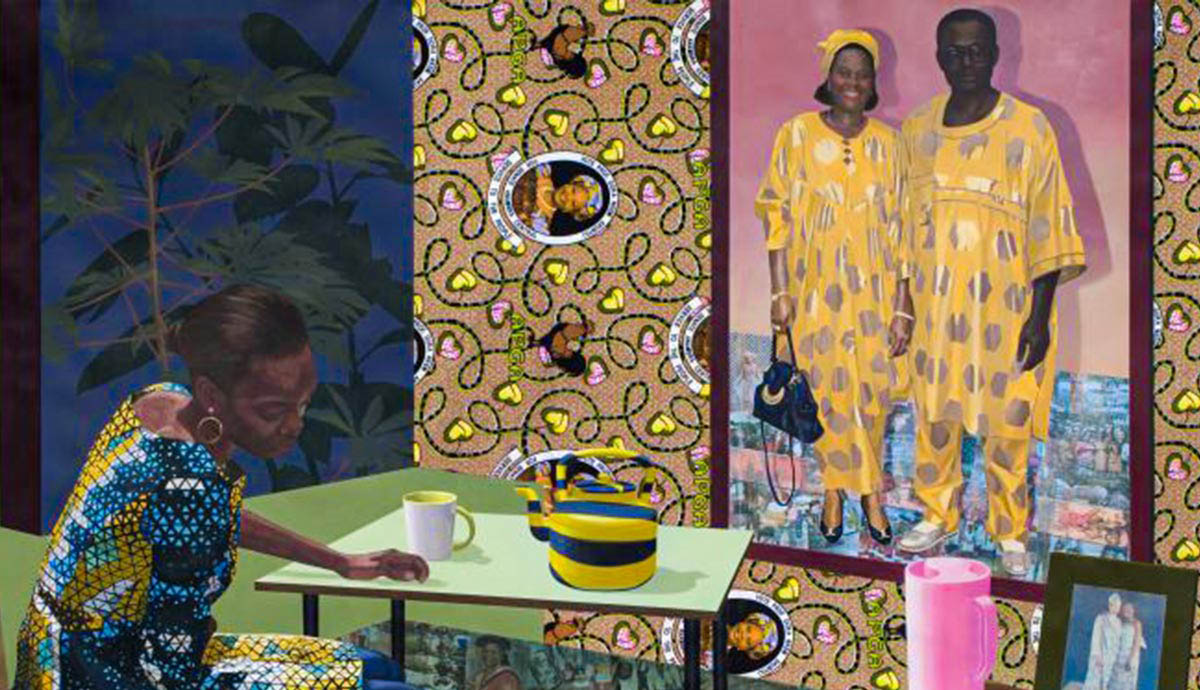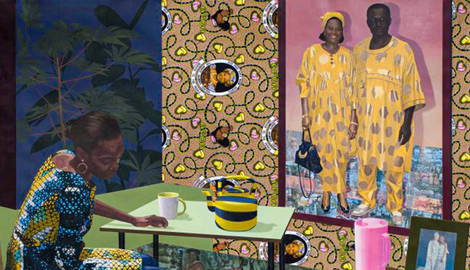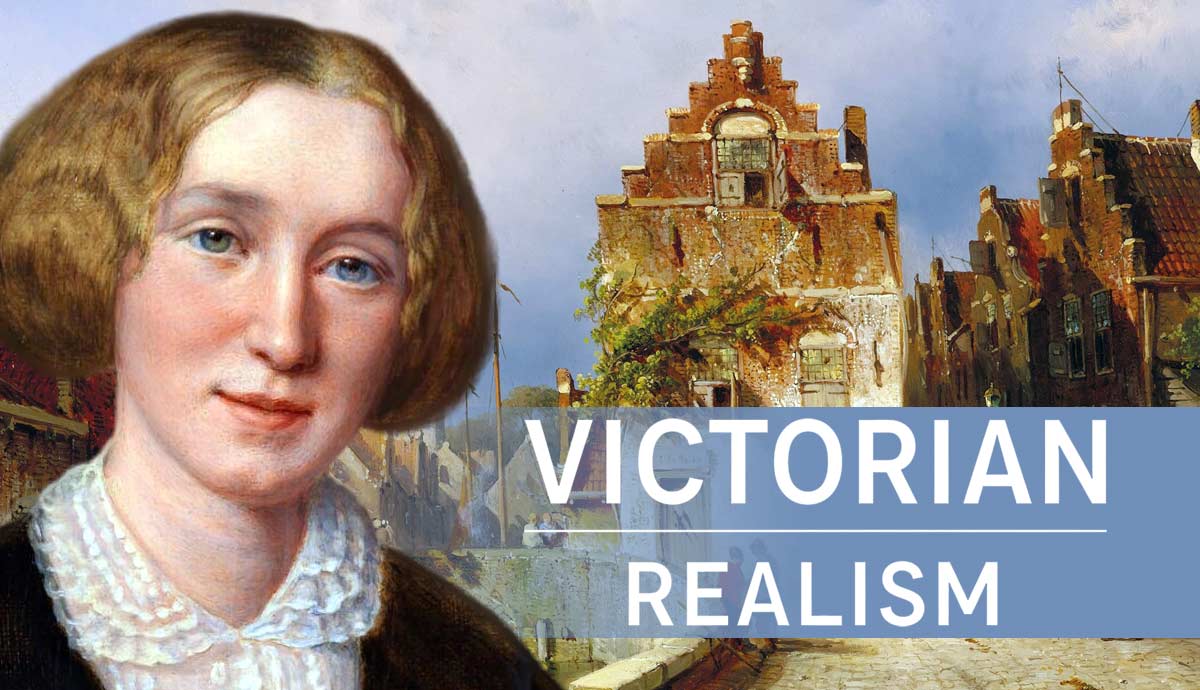
Njideka Akunyili Crosby burst onto the art scene in 2010 with her large-scale mixed media works that mix figurative painting, drawing, printmaking, photography, and collage. Her layered compositions of interiors combine her LA surroundings with images from her birth country Nigeria and recall the complexity of contemporary experience. This article reveals everything you need to know about this influential artist by looking at ten important masterpieces.
1. 5 Umezebi Street, New Haven, Enugu, Njideka Akunyili Crosby, 2012

Born in 1983 in Enugu, a former coal-mining town in Nigeria, Akunyili Crosby’s family spent weekends and summers in her grandmother’s rural village. At age 11, Njideka attended boarding school in the more cosmopolitan city of Lagos. Already in Nigeria, Akunyili Crosby noticed the different lifestyles in the city and the countryside and how she felt part of more than one geographical place.
Compared to the modern interiors set in LA, Njideka Akunyili Crosby’s African interiors are more traditional with simple wood furniture and faded upholstery. 5 Umezebi Street, New Haven, Enugu, shows several people in a room, probably family members. A woman sits at a table drinking, a child asleep on her lap. More children are playing in the corner. A man stares out of a window. We can’t quite tell what brings these people together. This is one of Akunyili Crosby’s early works, where foreground and background are not clearly delineated. The people, the furniture, and the window seem to float in the space.
2. Mama, Mummy And Mamma, 2014

After her mother won a green card lottery in 1999, Njideka Akunyili Crosby’s family moved to Philadelphia, where Njideka took her first oil painting class at the local community college. She studied fine art and Biology at Swarthmore College and completed an MFA in painting at Yale University in 2011. She now lives in LA with her husband and children.
In Mama, Mummy and Mamma, the interior is simple, with a large table taking up almost half of the work’s surface. There are subtle references to Nigeria. Akunyili Crosby’s grandmother (Mama) is imagined through the objects that occupy her home. A kerosene lamp, a recurring motif in Akunyili Crosby’s work, refers to the lack of electricity in rural areas in Nigeria: places like her grandmother’s village. There are also teacups and a teapot, alluding to the tea culture derived from British colonialism. Christianity, another colonial import, is referenced with the two framed images of the Virgin Mary.
The woman at the table is Akunyili Crosby’s sister (Mamma), and the picture on the wall is of their mother as a young girl (Mummy), thus completing this clever portrait of three generations.
As in all of Akunyili Crosby’s work, ideas of home, hospitality, and generosity mingle with thoughts about cultural inheritance in a broader sense.
3. ‘The Beautyful Ones Are Not Yet Born’ Might Not Hold True For Much Longer, 2013

Njideka Akunyili Crosby spends two to three months on a work, producing only a handful of monumental works each year. Her works are broken down, transferred onto transparent films, and projected and retraced onto the final support. The result is an exciting fusion of different layers, mixing figurative painting, drawing, printmaking, photography, and collage. Pushing the boundaries of painting is as essential to Akunyili Crosby as the work itself.
Although Njideka Akunyili Crosby’s later works all depict interiors in Los Angeles, her Nigerian heritage is still visible. At a closer look, the patterns of the floors and walls turn out to be made of tiny screen-printed images that the artist collects from Nigerian newspapers, popular African magazines, and family photo albums, and then prints onto the paper using a mineral-based solvent (Robert Rauschenberg used this technique to significant effect in his work starting in the late 1950s.)
The title of the work, ‘The Beautyful Ones Are Not Yet Born,’ refers to a text by Ghanaian writer Ayi Kwei Armah, published in 1968. It refers to the Nigeria of today, which is slowly coming out of the shadow of British colonialism.
4. ‘The Beautyful Ones’ Series 1c, 2014

Njideka Akunyili Crosby’s ongoing series, “The Beautyful Ones,” comprises portraits of Nigerian youth, including some members of the artist’s family. The series was exhibited at London’s National Portrait Gallery in 2018.
Between her undergraduate and postgraduate degrees, Akunyili Crosby moved back to Nigeria for a year. She noticed a buzz and vibrancy that she hadn’t seen before: young artists, fashion designers, and the Nollywood film industry. It was as if, after years of colonialism and the slow building-up of independence, the country was thriving and going through something of a Renaissance. In her transfers and her portraits of Nigerian children, Akunyili Crosby wanted to render this everyday life in Nigeria. She found that in America, her home country was often depicted as the scene of crises. People tend to forget that everyday life exists there, too. People hang out, wear nice clothes, get married, and spend time with family and friends.
5. ‘The Beautyful Ones’ Series 2, 2013

The subjects in The Beautyful Ones are often children. The young boy in Series 2 is wearing a green overall with bright yellow pockets. His gaze conveys a mix of pride in his surroundings and the insecurity that comes from being a child.
Akunyili Crosby’s works often feature plants, and sometimes the lush green foliage is the main subject of a painting, interspersed with transfers from magazines. Here, the lyrical green lines of the plants in the background contrast beautifully with the bright yellow and soft pink of the modern interior. For Akunyili Crosby, plants are another way of merging different cultural references. She often mixes species from different places to subtly hint at the cosmopolitan nature of contemporary life.
6. Dwell (Aso Ebi), Njideka Akunyili Crosby, 2017

Njideka Akunyili Crosby’s work is monumental in scale and contains many layers. There are figures populating interiors, engrossed in whatever they are doing: reading, eating, or sometimes just looking ahead, concentrated in thoughts. There are simple items of furniture, often brightly colored, containing a few domestic objects. At a closer look, more images reveal themselves: faces appear on patterned wallpaper and cross over into the floors.
In Dwell: Aso Ebi, a woman sits on a chair looking down on her elegant feet in blue tights. Her dress is a brightly colored geometric design as if she is comfortably wearing a Modernist painting. The wallpaper’s design with chickens and yellow hearts is from fabrics that the artist collects from her native Nigeria. It also features repeated portraits of her mother, Dora, as a queen-like figure. Akunyili Crosby’s parents were both doctors. Her mother gained a Ph.D. and became a government official, heading up the Nigerian version of the Food and Drug Administration. The straight lines of the furniture and walls contrast with the dark foliage outside the window; the African dress in the framed portrait of the artist’s parents contrasts with the bold, geometric design of the dress the main character is wearing. But all the different textures and colors coexist harmoniously on the picture plane.
The same female figure appears throughout Akunyili Crosby’s works. This elegantly dressed woman is the artist’s alter ego; she represents someone from the African diaspora, seamlessly moving between continents and cultures.
7. I Still Face You, 2015

Njideka Akunyili Crosby also paints her family members and friends. I Still Face You, in this case, depicts a group of familiar young people.
Akunyili Crosby met her husband, a white man from Texas, at Swarthmore College, and as such, a mixed-race couple often appears in her work. The two were married in both a church and a village wedding in Nigeria in 2009, following a campaign by the artist to get her father accustomed to the idea. It was expected for her father’s generation that a woman would marry someone from her own country. However, Akunyili Crosby wanted to show him that another sort of life is possible, mixing countries and cultures in one marriage.
When painted in pairs or groups, Akunyili Crosby’s figures rarely meet the viewer’s gaze. Instead, they seem bound up in moments of reflection left open to interpretation by the viewer. Akunyili Crosby’s subjects appear resigned and calm, showing few emotions. Her works render the characters’ mood more than any specific facial features. There is a balance between intimacy and longing, between pleasure and nostalgia.
8. Super Blue Omo, 2016

Njideka Akunyili Crosby takes her inspiration from a wide range of artists: Carrie Mae Weems, Danish painter Vilhelm Hammershoi, and Edgar Degas for his color palette. She samples from art history, mixing different styles, just as she mixes her Nigerian and American life in the subject matter of her work. Her intimate, sparsely populated interiors and her detail of rendering patterns and textures also recall Dutch seventeenth-century artist Johannes Vermeer.
Njideka Akunyili Crosby tells stories through her work, and she is inspired equally by literature, mostly by Nigerian authors such as Chinua Achebe and Chimamanda Ngozi Adichie. But the stories in Akunyili Crosby’s work remain somewhat opaque, to be completed by the viewer. In Super Blue Omo, there are references to “Omo,” a well-known brand of washing powder of the 1980s, but also to the color blue, which suggests the emotional state of the character staring off into the distance.
The piece compels the viewer to wonder: why are there two teacups on the table? Is she waiting for someone, and if so, for whom? An advertisement, most likely for the laundry detergent, is playing on an old television, while the rest of the interior looks cool and contemporary. What exactly we are witnessing remains somewhat mysterious.
9. Obodo (Country/City/Town/Ancestral Village), 2018

Njideka Akunyili Crosby likes her work to be installed without frames and pinned directly to the wall in order to enhance the directness of the images. Akunyili Crosby’s paintings’ cinematic nature also lends itself very well to large installations – her paintings have been displayed as murals on the side of buildings in London, Los Angeles, and New York. This opens up her work to a much larger audience than the people who visit a museum.
The title of this work, displayed on the outside of MOCA, alludes to an ancestral village in Nigeria, but it is rendered in a very different setting, namely the urban landscape of downtown Los Angeles. Again, Akunyili Crosby freely mixes various cultural references to great effect, creating a disjuncture but also a bringing-together of different times and places.
10. When the Going Is Smooth And Good, 2017: Njideka Akunyili Crosby’s Works Are A Dance With Life

Njideka Akunyili Crosby’s impressive works are portals of some kind or another, providing glimpses into her personal life while momentarily transporting the viewer to the domestic spaces she experienced as a child in Nigeria. Their layered compositions recall the complexity of contemporary experience.
In When the Going is Smooth and Good, a group of young people dressed in bright party clothes is dancing. They are intimate with each other and are clearly enjoying themselves. Njideka Akunyili Crosby ultimately celebrates people in all their appearances and interactions. She shows us the power that comes from feeling truly at home.










